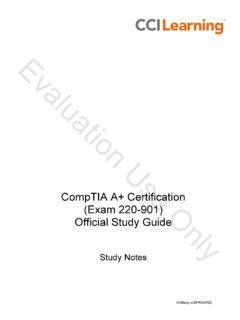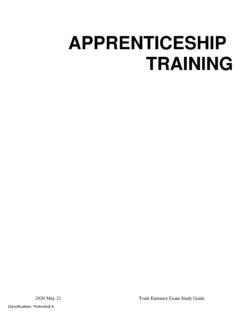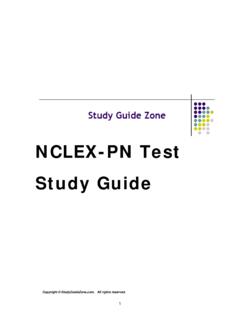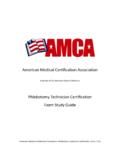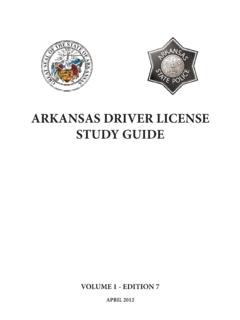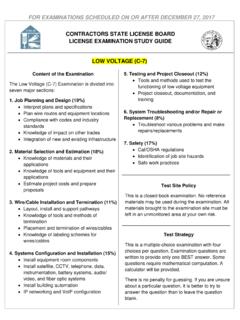Transcription of Self-Paced Study Guide in Trigonometry
1 Self-Paced Study Guide in TrigonometryMarch 31, 20111 CONTENTSTRIGONOMETRYC ontents1 How to Use the Self-Paced Review Module32 Trigonometry Self-Paced Review Triangles .. Special Triangles .. Angle Measure .. Functions as Functions .. Identities .. and Cosine Laws for the General Triangle .. Laws of Sines .. Law of Cosines .. to Exercises .. 193 Trigonometry Problems and triangles and trigonometric functions .. values of the trigonometric functions .. measure .. graphs .. identities .. of Sines and Law of Cosines .. 284 Trigonometry Self-Tests and Diagnostic Test #1 .. to Trigonometry Diagnostic Test #1 .. Diagnostic Test #2 .. to Trigonometry Diagnostic Test #2 .. 415 Self-Evaluation422 TRIGONOMETRY1 How to Use the Self-Paced Review ModuleTheSelf-Paced Reviewconsists of review modules with exercises; prob-lems and solutions; self-tests and solutions; and self-evaluations for thefour topic areas Algebra, Geometry and Analytic Geometry, Trigonom-etry, and Exponentials & Logarithms.
2 In addition, previousDiagnosticExamswith solutions are included. Each topic area is independent of Modulesare designed to introduce the core material foreach topic area. A numbering system facilitates easy tracking of subjectmaterial. For example, in the topic area Algebra, the subtopic LinearEquations is numbered by Problems and self-evaluations are catego-rized using this numbering using theSelf-Paced Review, it is important to differentiate be-tween concept learning and problem solving. The review modules areoriented toward refreshing concept understanding while the problemsand self-tests are designed to develop problem solving ability. Whenreviewing the modules, exercises are liberally sprinkled throughout themodules, and should be solved wile working thorugh the module.
3 Theproblems should be attempted without looking at the solutions. If a prob-lem cannot be solved after at least two honest efforts, then consult tests should be taken only when both an understanding of thematerial and a problem solving ability have been achieved. The self-evaluation is a useful tool to evaluate one s mastery of the material. Theprevious Diagnostic Exams should provide the finishing review modules were written by Professor A. P. French (PhysicsDepartment) and Adeliada Moranescu (MIT Class of 1994). The problemsand solutions were written by Professor Arthur Mattuck (MathematicsDepartment). This document was originally produced by the Undergrad-uate Academic Affairs Office, August, 1992, and transcribed to LATEX forOCW by Tea Dorminy (MIT Class of 2013) in August, Trigonometry Self-Paced Review ModuleAs you probably know, Trigonometry is just the measurement of trian-gles , and that is how it got started, in connection with surveying theearth and the universe.
4 But it has become an essential part of the lan-guage of mathematics, physics, and Right TrianglesACBcba The simplest place to begin this review is with righttriangles. We just have an angle (0 < <90 ), andthe lengths of the sidesa,b,c. With this labeling of thesides, we have:ais the sideoppositeto ;bis the sideadjacentto ;cis thehypotenuse(literally the stretched side ).From these we construct the three primary trigonometric functions sine, cosine, and tangent:sin =ac;cos =bc;tan =ab=sin cos Some people remember these through a mnemonic trick the non-sense word SOHCAHTOA:Sine=OppositeHypotenuse;Cosine =AdjacentHypotenuse;Tangent=OppositeAdja centPerhaps you yourself learned this. But you ll be much better off if yousimplyknowthese relations as a sort of reflex and don t have to thinkabout which ratio is will also need to be familiar with the reciprocals of these functions cosecant=1/sine;secant=1/cosine;cotangen t=1/tangent :csc =1sin =ca;sec =1cos =cb;cot =1tan = Right TrianglesTRIGONOMETRYIf we wish, we can of course express the hypotenusecin terms ofaandbwith the help of Pythagoras Theorem:c2=a2+b2, soc= a2+b2= (a2+b2)1/2 Exercise : 43 Cover up the formulas findsin , cos , tan , csc , sec , cot in the trian-gle shown here.
5 (We ve deliberately drawn itin a non-standard orientation; you need to beable to handle that sort of thing.)Note: The answers to the exercises are all collected together at the endof this module. We have tried to eliminate errors, but if you find anythingthat you think needs to be corrected, please write to :In this triangle, find:1. sin(90 )2. sin +cos(90 )3. tan +cot(90 )4. sec +csc(90 )135 ACB90 [Note: 90 is a perfectly valid name for the angle atB, thoughfor some purposes we might want to call it, say, for simplicity. Butthe important thing here is just to get the relation of the sines andcosines, etc., straight. Here, is what we might call theprimaryangle,90 is theco-angle(complementary angle). The above exercise isdesigned to make the point that the sine, tangent and secant of theangle have the same values as the co-sine, co-tangent, and co-secantof the co-angle(90 ) and vice versa.]
6 ]Exercise :Sorry, folks. No picture this the an acute angle and sinA=7/25, find all the other trigono-metric functions of the Some Special TrianglesTRIGONOMETRYIMPORTANT!It s not enough to know thedefinitionsof the various trigonometricfunctions. You also need to be able tousethem to find the length of anyside of a right triangle in terms of any other side and one of the is, in the triangleABC, in whichCis the right angle, you should befamiliar with the following relationships:a=btan =csin =ccos =bcot b=acot =ccos =csin =atan c=acsc =bsec =asec =bcsc ABCabc In particular, the relations a=csin , and b=ccos , correspond to theprocess of breaking up a linear displacement or a force into two operation is one that you will need to perform over andover again in physics problems. Learn it now so that you have it readyfor instant use :In a right triangle labeled as above, find:a)BC, ifA=20 ,AB=5;b)AC, ifB=40 ,BC=8;c)AB, ifA=53 ,AC= Some Special TrianglesWe ve already used some special triangles in Section 1, above righttriangles in which all three sides can be expressed as integers: (3, 4, 5),(5, 12, 13), and (7, 24, 25).
7 It s very convenient to be familiar with suchtriangles, for which Pythagoras Theorem becomes just a relation betweenthe squares of the natural numbers. (You might like to amuse yourselfhunting for more examples.) And people who set examinations are fondof using such triangles, to save work for the students who write the examsand for the people who grade them. So there can be a very practicaladvantage in knowing them! Some Special TrianglesTRIGONOMETRYAnd there are some other special triangles that you should know in-side out. Look at the two triangles below. No doubt you re familiar withboth of them. The first is half of a square and the second is half of anequilateral triangle. Their angles and principal trigonometric functionsare as 245 45 sin 45 =1 2= cos 45 tan 45 = 121 3sin 30 =12= cos 60 cos 30 = 32= sin 60 tan 30 =1 3= cot 60 30 60 These triangles, too, often show up in quizzes and examinations.
8 Youwill very likely be expected to know them in tests where calculators arenot allowed. More importantly, though, they should become part of yourstock-in-trade of known numerical values that you can use for problem-solving. Getting anapproximateanswer to a problem can often be veryuseful. You might, for example, be doing a problem in which the cosineof shows up. Maybe you don t have your calculator with you ormaybe it has decided to break down. If you know that cos 60 =1/2, youcan use this as a good approximation to the value you really want. Also,since (for angles between 0 and 90 ) the cosine gets smaller as the anglegets bigger, you will know that the true value of cos 58 is a littlebiggerthan 1/2; that can be very useful information :Take a separate sheet of paper, draw the 45 /45 /90 and30 /60 /90 triangles, and write down the values of all the trig func-tions you have the values to decimal form Radian Angle MeasureTRIGONOMETRYE xercise :Given: this triangle, withC=90.
9 Find all angles and lengths of thesides if:a)A=30 ,b=6b)a=13,b=13c)B=30 ,c=10d)A=45 ,c=12e)c=1,b= 2f)c=4,b=4 ACBcba Exercise :PQ45 30 A tall flagpole stands behind abuilding. Standing at pointP,you observe that you must lookup at an angle of 45 to see thetop of the pole. You then walkaway from the building througha distance of 10 meters to pointQ. From here, the line to the topof the pole makes an angle of 30 to the horizontal. How high is the top of the poleabove eye level?[If you don t see how to approach this problem, take a peek at thesolution just the diagram at first.] Radian Angle Measure A given angle is uniquely defined by the intersection oftwo straight lines. But the actualmeasureof the angle canbe expressed in different ways. For most practical purposes( , navigation) we use the division of the full circle into 360degrees, and measure angles in terms of degrees, minutes,and seconds of arc.
10 But in mathematics and physics, Radian Angle MeasureTRIGONOMETRYare usually expressed inradians. Radians are much more useful thandegrees when you are studying functions, graphs, and such things asperiodic motion. This is because radians simplify all calculus formulasfor trig functions. The price we pay for simplicity is that we need tointroduce the fundamental constant . But that is worth movableRImagine a circle, with an angle formed betweentwo radii. Suppose that one of the radii (the hori-zontal one) is fixed, and that the other one is freeto rotate about the center so as to define any sizeof angle we please. To make things simple, choosethe circle to have radiusR=1 (inch, centimeter,whatever it doesn t matter). We can take someflexible material (string or thread) and cut off a unit length of it (the sameunits as we ve used forRitself).










